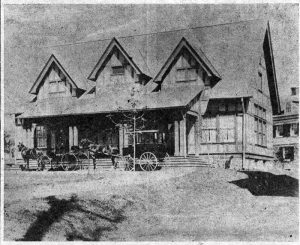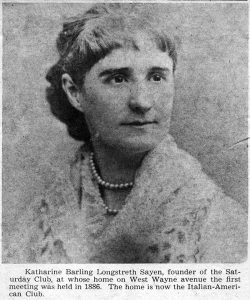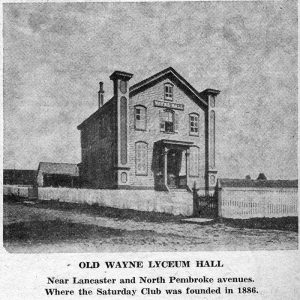The names of the presidents during the first ten years of the Saturday Club’s existence were given in this column in the October 11 issue. During the next ten years, 1896-1906, which were important ones because of the building of the clubhouse, presidents were Mrs. W.B. McKellar, Mrs. George Miles Wells, Mrs. C. W. Ruschenberger, Mrs. Ralston C. Ware, Mrs. Ellis L. Campbell, Mrs. William A. Nichols and Mrs. Clarke J. Wood.
Probably the most important event of the 1906-1916 period was the 12th annual convention of the State Federation of Pennsylvania Club Women, held at the Devon Inn, with the Saturday Club as host club. Some 400 women were in attendance, coming to Devon from all sections of Pennsylvania.
And what were the clubwomen discussing at this time? These were the topics of some of their convention addresses: “Child Labor Regulation in Pennsylvania,” “Home Economics as an Educational Phase in Civics,” “The Movement Towards Civic Beauty” and “Moral Training in Public Schools.” Mrs. Edward W. Biddle of Carlisle, who was to succeed Mrs. Ellis Lewis Campbell as state president, was much interested in education in Pennsylvania. She felt that school taxation was quite inadequate to introduce manual training, school libraries and many other adjuncts, such as schools in neighboring states enjoyed at that time.
Mrs. Henry Roever’s presidency, beginning in 1914, was succeeded by that of Mrs. Marshall H. Smith, Mrs. W. Allen Barr, Mrs. John J. Mitchell, Jr., Mrs. Walter H. Dance and Mrs. Charles H. Howson. This was the period of World War I.
Programs included music, letters from the front and tableaux; a home economics program had as its title “Food Values and Substitutes as a Means of Food Conservation.”
Just before Christmas, 1917, the hospitality of the club was extended to 25 marines from the Philadelphia Navy Yard, with senior members of the club cooperating with the Junior Saturday Club. There were canteen luncheons and service days at the club house, when members were urged to bring any work they might be doing for men at the front. There was a vaudeville show, put on by the juniors for the benefit of a Fund for French Orphans.
At the end of February, 1918, the club house was closed by the coal shortage, not to be reopened until April, and meetings were held at the homes of various members. At the end of April, as a response to a request from the Government, a “War Kitchen” was held in the club house for a short period of time. During the influenza epidemic the building was turned into a hospital for those who could not gain admittance to regular hospitals.
In November, 1918, came the Armistice and, with it, happier days in the life of the club. Presidents of the 1928-1956 period were Mrs. Henry Roever, Mrs. Frederick A. McCord, Mrs. E. Earl Trout, Mrs. Paul Gant, Mrs. T. Magill Patterson (two terms of office), Mrs. H.H. Kynett, Mrs. F. Ashby Wallace, Mrs. J. Stewart Freeman, Mrs. A.E. Livingston, Mrs. Richard Howson, Mrs. J. Russell Hogeland, Mrs. Spencer V. Smith, Mrs. J. Leroy Vosburg and Mrs. G. Rushton Howell, the present incumbent.
World War II had its effect on club activities, at the end of Mrs. Kynett’s administration, as well as through those of Mrs. Wallace and Mrs. Freeman. Less time was given to club work and more to Red Cross. As its direct contribution to the local war effort, the club house was turned over to the local unit for all “blood donor days.”
In closing today’s “Your Town and My Town,” your columnist would like to call the attention of her readers to the fact that those “social, bright, congenial women” who gathered in Mrs. Sayen’s parlor in the early winter of 1886 to discuss “the subject of women’s clubs – then almost a tabooed one” started a local organization that now numbers some 300 members.
These women are active in the Saturday Club in more than 30 divisions of women’s club activities as organized by the General Federation of Women’s Clubs and the Pennsylvania State Federation. The former is the largest and most powerful organized group of women in the world today, yet the Saturday Club outdates the formation of that great organization by some four years!



